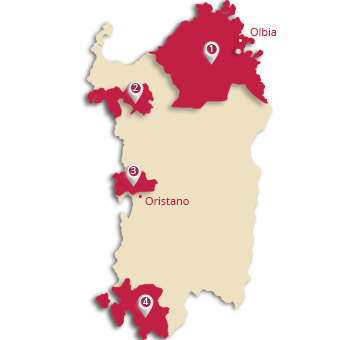Sardinia: the new frontier
Sardinia, situated strategically in the center of the Mediterranean, has been a land of conquest throughout the centuries: first the Phoenicians, then the Romans, then the Catalonians, then the Aragons, followed by the Spanish and finally the Piedmontese. Besides imposing their customs and costumes, all these different cultures have left their imprint regarding the cultivation of vine. Ancient wine-making traditions of the island are recorded by the "Carta de Logu" a decree written in 1392 in which Eleonora, sovereign of Giudicato di Arborea, ordered that vineyards be planted on the remaining uncultivated terrain. A land scorched by sun, Sardinia is characterized by a cultivation of the vineplants "ad alberello" (like small trees), which allows the grapes to remain as far as possible from the heat emanating from the earth. Until not long ago, Sardinia was known for its production of white wines with complex structure and high alchoholic content. Today, Sardinia has abandoned the focus on mass production and is concentrating on continually improving the quality of its vintages. Small producers and shrewd wine-cellar cooperatives, aided by the particularly ideal climate, are bringing forth some excellent wines that go beyond the scope of the traditional vintages of the island: for this reason we can consider Sardinia to be "the new frontier" of Italian wines. Let's take a look at the principle zones.
In the northern part of the island we find the zone of Sassarese, known throughout the world for the beauty of its spectacular landscape, where the blue of the sea accents the earthy tones of the rocks and Mediterranean vegetation. Vermentino di Gallura is made here, a white D.O.C.G. obtained from a vine of Ligurian descent. It has a subtle bouquet, intense and delicate, that is an excellent match with the Sardinian seafood. Other wines of note are produced in the area of Alghero, a picturesque village with strong Spanish influences. Wandering its narrow stone streets you can still hear the language of its ancient conquerors: Catalanian.
The Oristanese zone lies in the central part of the island. The symbolic wine of Sardinia is produced here: Vernaccia di Oristano. Obtained from and autoctonic vine named after the city of Oristano, it was the first Italian wine to attain the classification of D.O.C. It has a high alchoholic content (easily over 15%), a yellow gold or amber color, a delicate bouquet with hints of almond flower and a pleasing, slightly bitter aftertaste.
In the southern tip of the island we have the zone of Cagliaritano, an important area of vineyards where we can find representations of almost all the D.O.C. Sardinian wines. Among them, of special interest is Nuragus di Cagliari, a white wine obtained from a vine that some maintain was introduced by the Phoenicians, while others insist that its origins are exclusively Sardinian, and also Cannonau di Sardegna, a red or rosé with a pleasing characteristic bouquet, that originates from the Cannonau vine, one of the most common strains on the island, which is believed to have been imported from Spain.
Click on any zone to discover it's wines









